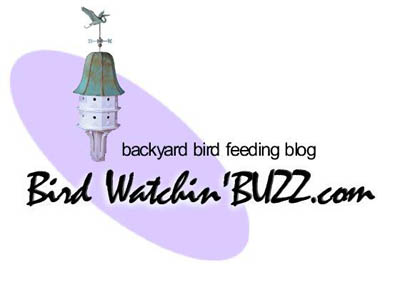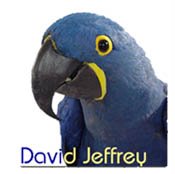 This month I celebrated my first anniversary of making the decision to build a website about birds ... mostly about backyard birdwatching. Since I have a nice family of exotic birds I couldn't help but include a little about them, too. It's been quite a journey and is directly responsible for my having this blog. I began this Internet project knowing absolutely nothing about building a website or any of the satellite "stuff" it led to.
This month I celebrated my first anniversary of making the decision to build a website about birds ... mostly about backyard birdwatching. Since I have a nice family of exotic birds I couldn't help but include a little about them, too. It's been quite a journey and is directly responsible for my having this blog. I began this Internet project knowing absolutely nothing about building a website or any of the satellite "stuff" it led to.
If not for a friend of mine in Canada I never would taken on such an endeavor. She gave me the encouragement. My thanks to her is sincerely given. Since my passion is birds it has been very satisfying to create Birdwatchin'.com. But I never could have even remotely considered doing so without a very affordable program used by thousands of people around the world. For anyone who has considered creating a website to promote an interest or earn an income I can highly recommend checking it out. It truly over-delivers. There are a lot of examples of what people have accomplished with this tool. If you want to see what a real Internet novice (and I do mean beginner) has been able to do using this program ... then take a look at Birdwatchin.com. I'm still find it incredible that I actually did it. It amazes me!
Anyway, the website has led to other activities such as this blog. And it is also the reason I'm launching a newsletter called David's Wild Bird News! The first issue is due to come out in the next few days. Who is David? ... actually, his full name is David Jeffrey (there's a reason for the double name ... I'll explain tomorrow). David is my Hyacinth Macaw. He "volunteered" to be the host of the newsletter. I'm just his assistant. Anyway, if you love bird watching check out Birdwatchin.com and subscribe to the newsletter ... it's free!
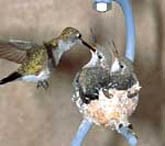 I've been planning my backyard to encourage my wild bird visitors raise a family. I'm really looking forward to observing wild birds behavior as it pertains to rearing babies. I've had the amazing personal experience of raising four Umbrella Cockatoos some years ago. Raising those babies was a real eye-opener because I learned first hand what labor-intensive work it is to get a baby bird to the fledging point. And that's just the beginning of the needs of a young bird until it is ready to survive by itself. Knowing first-hand about the work it takes makes my desire to help the wild birds stronger because they also have the challenge of survival.
I've been planning my backyard to encourage my wild bird visitors raise a family. I'm really looking forward to observing wild birds behavior as it pertains to rearing babies. I've had the amazing personal experience of raising four Umbrella Cockatoos some years ago. Raising those babies was a real eye-opener because I learned first hand what labor-intensive work it is to get a baby bird to the fledging point. And that's just the beginning of the needs of a young bird until it is ready to survive by itself. Knowing first-hand about the work it takes makes my desire to help the wild birds stronger because they also have the challenge of survival.
I don't remember any other experience that was as rewarding as watching my baby Umbrellas grow up. Only another person who has participated in such an event will really understand what I mean about reward. So with those memories well entrenched I've been trying to decide what kinds of bird house/nestboxes (how many and where) I should put up. While doing my research I came across a nesting platform made especially for hummingbirds. I didn't know such a thing existed. Anyway, when I saw it I knew I had to have it. Only one time in my life have I seen a nest of hummingbirds. There were 2 babies in the nest. They were so tiny -- frankly, I was transfixed as I stood there watching them. But the sad thing was ... a wind storm came the very next day and destroyed the nest. I could find nothing left. It broke my heart and I've never forgotten it.
So I'm thinking ... hmmm! perhaps this hummingbird nest platform will be just the ticket to accomplish two goals:
- The platform may provide a sturdy base for the hummingbird to build her nest and help prevent the kind of tragedy I encountered before.
- If I choose the place for mommy hummingbird to build her nest ... then I'll know where to find the baby hummingbirds. Being so small, hummingbird nests are hard to find ... but I'll know where to look.
The success of providing the nest will depend on where I put it. The hummingbird is going to have to like it's location ... that's for sure. So I'll do some more research about what type of environment and location is the best. Then this new adventure will begin.
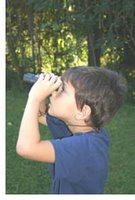 Got any little birders in your family that are budding and ready to bloom? Here's an idea to help them enjoy watching birds.
Got any little birders in your family that are budding and ready to bloom? Here's an idea to help them enjoy watching birds.
With spring just around the corner we're setting up bird house/nestboxes now so they'll be ready for the arrival of our avian visitors. It's pretty amazing to watch the progress of birds raising their families. It's even more enjoyable to watch little kids excitement over this kind of event. We want to rig a way to watch new bird babies on the inside of the nestbox. It's the ideal way to monitor their development and health ... not mention a terrific educational opportunity for kids. There's been a good amount of discussion around here about how to accomplish such a project easily. We've been making a list of equipment, accessories, etc. The project seemed somewhat daunting. Then I discovered that you can buy a nestbox all ready to record this amazing springtime event. Yippee! Check it out ... maybe offering such a nestbox would be perfect for your backyard.
Speaking of kids ... why not give them a fun project that will help the birds with their nesting activities. Here's an idea ... offer nesting material for the birds (see what's needed for the project below). No kids? Or maybe you just don't have the time for such a project. Then just get a kit all ready to offer. There are even nesting material replacements available for it, too.
Need some help choosing the right nestbox, this Birdwatchin.com guide will help you. Also check out the 10 most important features every nestbox should have.
Here's the Nesting Material Project:
Have the kids prepare a selection of materials from the following items (they've all been used by birds to build their nests). Then lightly pack the materials in a suet feeder and hang near your bird house. Use one or more of these material-filled feeders(*) depending the number of bird houses you are offering.
Yarn or string (cut the pieces about 4 to 6 inches)
Hair (human or animal hair -- horse hair is great)
Sheep's wool
Feathers
Shredded Paper
Dry Grass (use your clippings after mowing the lawn ... be sure they are chemical free)
Dead twigs and leaves
Straw
Plant fluff or down from Cottonwoods or Cattails
Cotton batting or other material used for stuffing
Moss
Bark Strips
Pine needles
Cloth (cut in stips 1/2" wide by 6" long)
(*) If you don't have a suet feeder to offer the nesting material just lay some of the natural items
on your plants and hedges, hang in trees, etc. It will help the birds, but won't be as much fun as watching the birds take the materials from a suet feeder that you've placed nearby.
Providing nesting opportunities for birds is the best way to celebrate the coming of spring.
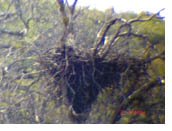 We took a drive to Lake Henshaw today for our first digiscoping experiment. After confirmation that Bald Eagles had an active nest there, I was eager to use my newly rigged-up digiscope to see if I could get a photograph of them.
We took a drive to Lake Henshaw today for our first digiscoping experiment. After confirmation that Bald Eagles had an active nest there, I was eager to use my newly rigged-up digiscope to see if I could get a photograph of them.
Due to an appointment I couldn't get to the lake until about 12:30 p.m. knowing that I couldn't stay long. Upon arrival there was no eagle in view. So, we decided to wait to see if either the hen or her mate would make an appearance.
The nest is huge -- so big that when an adult eagle is incubating it is not visable from below. The tree were the nest is located is upslope from the road where we must park and view. It is also about 300 yards from where we could set up the digiscope. So it is impossible to see if an eagle is in the nest.
After about 40 minutes of waiting to see an eagle I felt compelled to pack up and try again another day as I needed to be home by 3:00 p.m.
Then two ravens came soaring overhead ... one had nesting material in it's beak. That intrigued me so I followed it with my binocs. Both birds put on an interesting aerial show and I was captivated. Then I saw the bird drop the nesting material and a few moments later land on the ground. It picked up something ... I couldn't see what it was. It flew towards the lake shore and landed and proceeded to eat whatever it had picked up. Some poor hapless creature, no doubt. After a few minutes the raven's activity attracted 5 turkey vultures looking for a meal to steal. Since I hadn't had any luck with the eagles I decided to photograph the drama on the ground. Unfortunately, my photographic attempt failed. With that disappointment I decided it was time to go home.
Just my luck ... with the scope removed from sighting the eagles nest I turned just in time to see one of the bald eagles return to the nest. Wouldn't you know it! I had a great opportunity to get a pretty exciting burst of photographs (or even a movie) ... if I'd just been a little more patient. My first lesson in learning to photograph wild birds ... be patient and make sure the camera is set for the most optimal shot. Okay, so now you know how much of a novice I really am.
Although my first attempt met with failure, it was still an exciting hour of bird watching. You can be sure that I'll be back up at Lake Henshaw to try again. Oh, that eagles nest photo in the upper left corner is the one I photographed today ... sans the eagles., of course. Yep, I know it is pretty poor ... but didn't I just mention I'm a novice. So much to learn -- so little time!
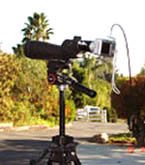 When I decided to create a website on bird watching I had no idea what other interests it would lead to. Then before I knew it a new word came to my attention ... digiscoping. I wondered what in the world digiscoping was? I soon discovered it meant taking photographs (in this case, of birds) with a digital camera shooting through a spotting scope. Wow! I thought what a great idea.
When I decided to create a website on bird watching I had no idea what other interests it would lead to. Then before I knew it a new word came to my attention ... digiscoping. I wondered what in the world digiscoping was? I soon discovered it meant taking photographs (in this case, of birds) with a digital camera shooting through a spotting scope. Wow! I thought what a great idea.
So I discussed the idea with my stepdad ... who is quite a guy. He is very handy and can do just about anything. He got intrigued with the idea and decided to help me learn how to take photographs this way. Well, he has taken the project really to heart. And found himself buying his second digital camera in just a few months, along with adapters, step-up and down rings, camera mounts, etc. All these accessories are necessary to adapt our current spotting scope to work like a digiscope. (Yep, there has been enough interest in digiscoping the last few years for the manufacturers to actually design photographic equipment called ... you got it ... a digiscope.) Then he got more inventive and rigged up a remote system that takes a photo without having to press the shutter button ourselves. This will eliminate camera-shake which is the quickest way to get a blurry photo.
We've gotten this far with our digiscoping experiment thanks to the opportunity to learn from the experts when we went to the San Diego Bird Festival a couple of weeks ago. That's where we found out about what type of digital camera works best and about the adapters we'd need. Thanks to the "experts" our digiscoping project is well underway. We finally located the step rings needed to connect the camera adapter to the spotting scope. So now we are ready to experiment.
We plan to photograph a Bald Eagle's nest at Lake Henshaw this weekend. Actually, we went to look for the nest a couple of weeks ago. We found it due to some easy directions offered by another birder. However, when we went to take a look the eagles were not apparent so we questioned whether the nest had been abandonded. Well, we just recently found out that the eagle was sighted in the nest. Her mate made an appearance, too. With this confirmation we've decided to try our luck getting our first digiscoped photo this weekend. I'll post the results next time.
Now I don't want to give you the wrong impression ... the idea for this project was mine, but all the ingenuity, labor and expense has been my stepdad's. Now you can really appreciate why I said he is "quite a guy".
 This month I celebrated my first anniversary of making the decision to build a website about birds ... mostly about backyard birdwatching. Since I have a nice family of exotic birds I couldn't help but include a little about them, too. It's been quite a journey and is directly responsible for my having this blog. I began this Internet project knowing absolutely nothing about building a website or any of the satellite "stuff" it led to.
This month I celebrated my first anniversary of making the decision to build a website about birds ... mostly about backyard birdwatching. Since I have a nice family of exotic birds I couldn't help but include a little about them, too. It's been quite a journey and is directly responsible for my having this blog. I began this Internet project knowing absolutely nothing about building a website or any of the satellite "stuff" it led to. 